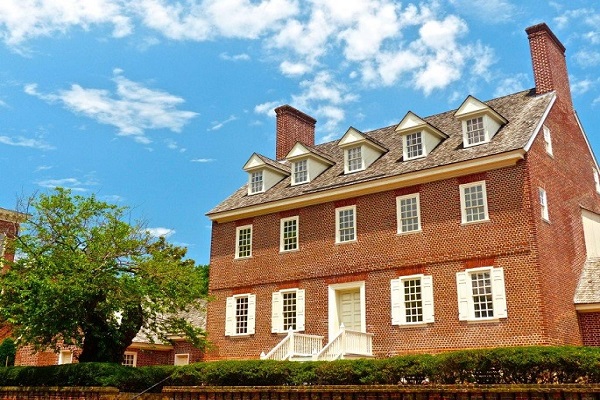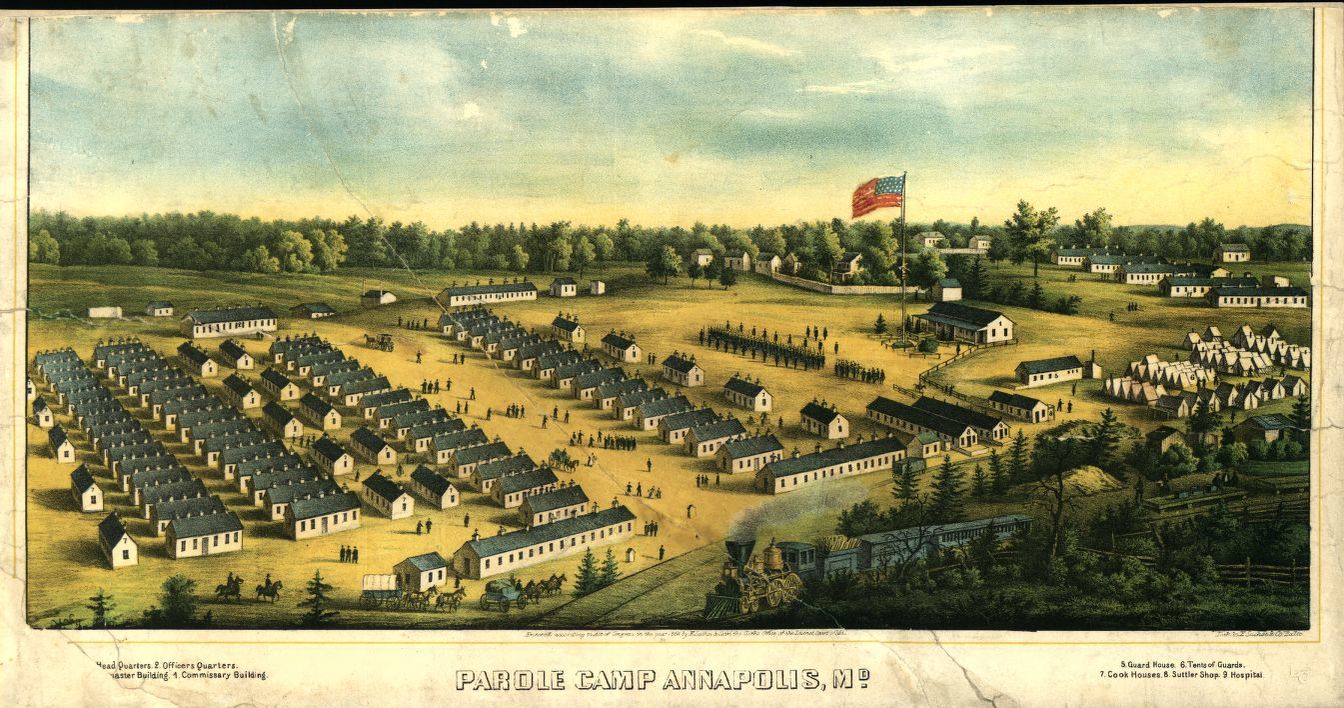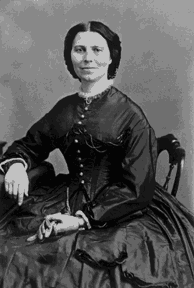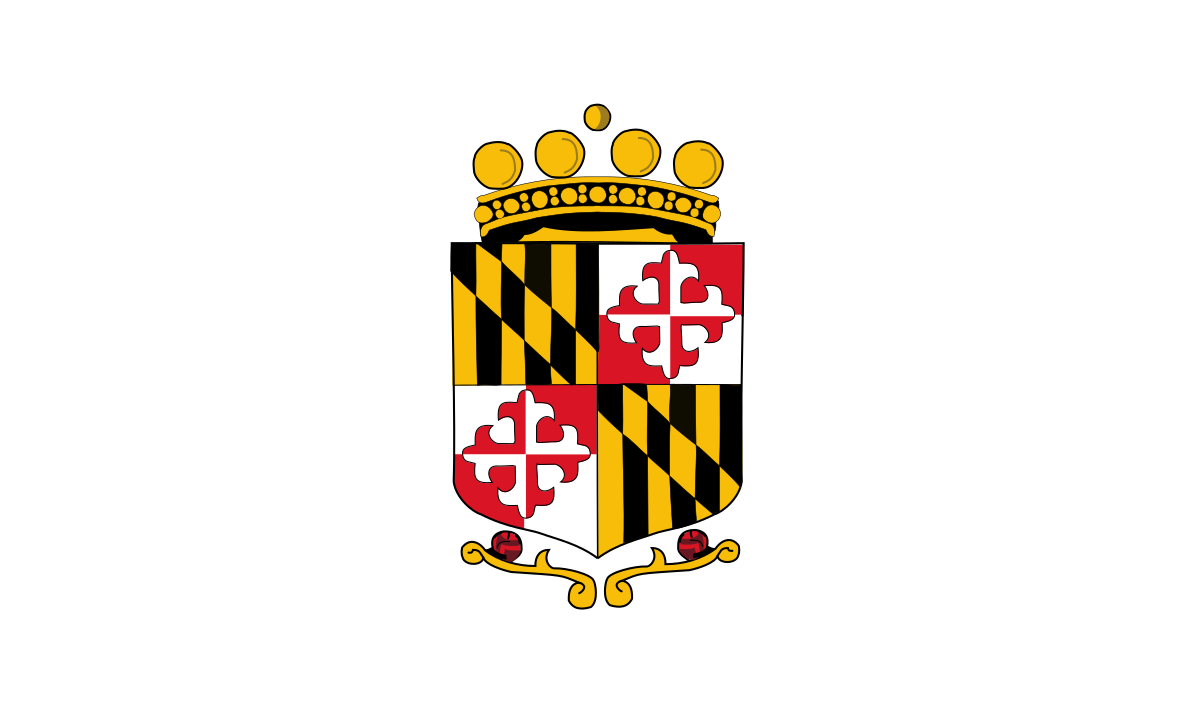In this feature, Preservation Maryland is exploring the unique history of five county flags across the state.
The Anne Arundel County Flag features the county seal on a white background. The county seal consists of the Calvert and Crossland coats of arms, similar to the Maryland flag. However, the Crossland arms use a cross fleur de lys as opposed to a cross bottony (rounded) to differentiate it from the rounded design used in the Maryland State Flag. Above the coat of arms is Charles Arundell’s coronet, a small crown worn by noblemen, with ermine and gold bands. Below the coat of arms are two gold brackets each with a thorn and a red rose.
Pre-Colonial and Colonial History
Prior to European colonization, a number of Indigenous tribes lived in what is now Anne Arundel County including the Piscataway, Nanticoke, and Susquehannock peoples. They lived in this region for thousands of years and are still active today, although they have been forced out of their ancestral lands along the Chesapeake. The Nanticoke primarily live in Northeastern states including Delaware and New Jersey.
Following European contact, King Charles I signed the Charter of Maryland in 1632, giving a new colony to Cecil Calvert, second Lord Baltimore. Calvert hoped Maryland would be a safe haven for Catholics. His father-in-law, Thomas Arundell, shared this vision. Following the death of Calvert’s father, Arundell provided financial assistance to Calvert for his new colony. Calvert became concerned about control of the colony when the English Civil War broke out in 1642. The conflict, with Roman Catholics supporting the Monarchy and Protestants supporting Parliament, jeopardized Calvert’s Royal patronage. Following the beheading of Charles I in 1649, Calvert replaced Maryland’s Catholic governor with a Protestant from Virginia, William Stone. Stone recruited a group of Puritans from his home state to settle in Maryland, promising them land and freedom. Their settlement, known as Providence, was located on the north shore of the Severn River, across from what is now Annapolis. That same year Cecil Calvert’s wife, Anne Arundell, passed away at the age of 34. One year later the Maryland General Assembly established the County and named it after her. Neither Cecil Calvert nor Anne Arundell ever set foot in Maryland.
Anne Arundel County was the site of the first colonial naval battle, the Battle of the Severn. In 1655, fighting from the English Civil War extended into the Colonies. Lord Baltimore’s forces sailed up the Chesapeake to regain control of Providence from the Puritans. However, the Puritans were victorious and retained the settlement until Oliver Cromwell re-established Calvert’s authority in 1657. Maryland became a royal colony in 1688, when King William III annulled Calvert’s Charter. Six years later, the Maryland General Assembly voted to move the capital from St. Mary’s City to Annapolis, which was at that time known as “Anne Arundell William Paca House.”
Chesapeake to regain control of Providence from the Puritans. However, the Puritans were victorious and retained the settlement until Oliver Cromwell re-established Calvert’s authority in 1657. Maryland became a royal colony in 1688, when King William III annulled Calvert’s Charter. Six years later, the Maryland General Assembly voted to move the capital from St. Mary’s City to Annapolis, which was at that time known as “Anne Arundell William Paca House.”
The Revolution through the Civil War
While the county did not see major Revolutionary Battles, it was the site of a number of significant events in the founding of the United States. In 1774, Annapolis had its own version of the Boston Tea Party with the burning of the merchant ship Peggy Stewart in Annapolis harbor. The owner of the ship had paid the British tea tax in violation of a non-importation resolution that was passed by colonists. A crowd demanded he destroy the ship and its cargo. Fearing for his family and his life, he set the ship on fire. In 1776, Anne Arundel residents William Paca and Samuel Chase were among Maryland’s signers of the Declaration of Independence. Construction on the Maryland State House in 1772. A little over ten years after construction began on the state house, Annapolis briefly became capital of the young United States while the Continental Congress met there. It was also the site of George Washington’s resignation from the Continental Army in 1783 and the signing of the Treaty of Paris, which ended the Revolutionary War, in 1784.

During the War of 1812, there was no fighting in Anne Arundel County. However, the threat of attack was on the horizon. British ships began attacking the Chesapeake coast in 1813, although they did not reach Annapolis. By 1814, Annapolis was somewhat deserted, but the remaining residents could see British ships in the harbor. During this time over 700 enslaved people from Maryland sought freedom on British ships, including 21 from Annapolis. The county fared similarly during the Civil War with no battles in the region. However, there were military training installations in the area and injured soldiers were often sent to county hospitals. Camp Parole was established on the grounds of St. John’s college as a prisoner exchange site between the Union and Confederate armies. Clara Barton, founder of the American Red Cross, established an Office of Missing Soldiers at the site. Families provided names of missing individuals and Barton would interview returning soldiers to locate or publish names and other information on those who were missing.
including 21 from Annapolis. The county fared similarly during the Civil War with no battles in the region. However, there were military training installations in the area and injured soldiers were often sent to county hospitals. Camp Parole was established on the grounds of St. John’s college as a prisoner exchange site between the Union and Confederate armies. Clara Barton, founder of the American Red Cross, established an Office of Missing Soldiers at the site. Families provided names of missing individuals and Barton would interview returning soldiers to locate or publish names and other information on those who were missing.
Early Agricultural and Industrial History
Like other regions of Maryland, Anne Arundel County relied on labor-intensive tobacco as its main cash crop. This agricultural economy relied on enslaved labor, so much so that at one point the enslaved population of the county exceeded that of European Americans. Tobacco depleted the soil and caused financial hardships for farmers. Nevertheless, it wasn’t until after the Civil War and the end of slavery that farmers in the county diversified their crops.
After the Revolution, the port city of Baltimore became a center of commerce. Concurrently, the iron ore mining industry grew in Anne Arundel County. Two iron works, the Curtis Creek Furnace in Glen Burnie and the Elkridge Furnace Complex (in what is now Howard County) were established in the late 18th and early 19th centuries, respectively. By 1840, the Annapolis & Elkridge connected to the Baltimore & Ohio Railroad, linking Annapolis to Baltimore, Washington, D.C. and points west.
In the 19th century many enslaved and free Black people worked in Annapolis, contributing to its growing industry. Enslaved women and young boys often performed domestic work in houses in the city. Some became craftspeople, working as blacksmiths, carpenters, and rope makers. They founded Black businesses, neighborhoods, and churches and created vibrant Annapolis communities. African Americans also played a role in maritime industries such as fishing, shipbuilding, and oystering. The historic communities of Galesville and Herington North are part of this heritage. In 2019, Preservation Maryland partnered with the County’s Cultural Resources division to preserve a piece of this history. The Six-to-Fix project focused on documentation and preservation of county burial sites, particularly African American cemeteries. The work has also resulted in workshops and webinars to train individuals on documenting and inventorying these sites.
Post-Civil War Development
Maryland’s fourth Constitution, ratified on November 1st, 1864, freed all enslaved people in the state. Following this, farmers turned to other crops including corn, fruit, and wheat. The increase in fruit and vegetable farming led to the development of canneries and fertiziler plants in the county. Eastern European immigrants were transported from Baltimore to work on these farms. The seafood industry, including fishing and shucking, also expanded during this time.
With the development of transit in the county in the 1880’s came the growth of recreation and tourism. The railroad and steamboats brought people to new resorts such as Bay Ridge and Highland Beach. The latter was established in 1893 by Charles Douglass, the son of Frederick Douglass, after he and his wife were turned away from a Bay Ridge restaurant because they were Black. It was established as an African American resort community and, following its incorporation in 1922, became the first African-American municipality in Maryland. Twin Oaks, the house built by Charles Douglass for his father, is now the Frederick Douglass Museum and Cultural Center. It recently received a Heritage Fund grant from Preservation Maryland to support two new exhibits and an inventory of their resources.
Anne Arundel County in the 20th Century
During World War I and World War II industry expanded in the county. Fort Meade was established as a training camp in 1917 and expanded to include a prisoner of war camp during World War II. Odenton’s economy boomed due to the influx of military personnel. Large companies such as the National Plastics Corporation (Nevamar) and Westinghouse moved into the county, employing thousands. Despite this industrial growth, the eastern and western parts of Maryland remained disconnected until after World War II. The Chesapeake Bay Bridge, which connects Sandy Point State Park to Kent Island, was completed in 1952. It carried 30,000 cars across in its first three days, opening up commerce and tourism between eastern and western Maryland.

